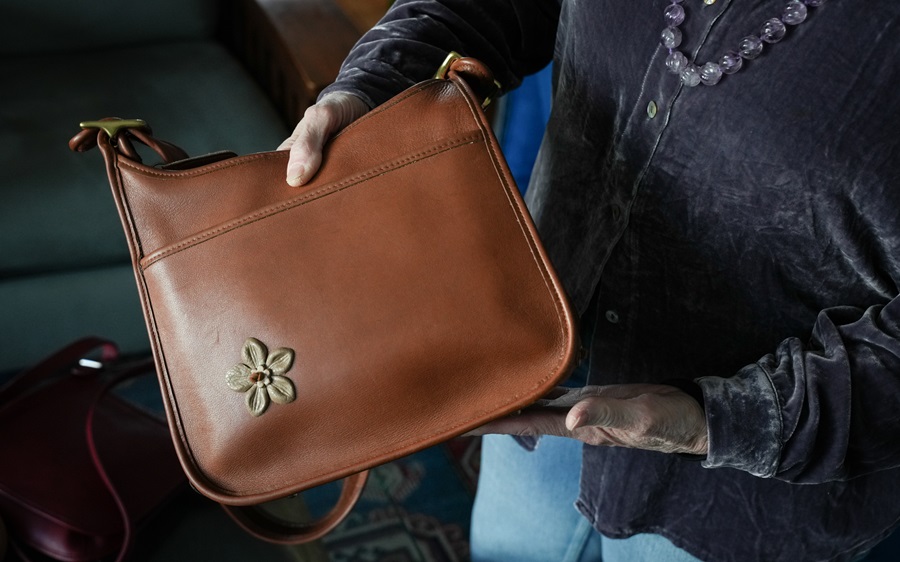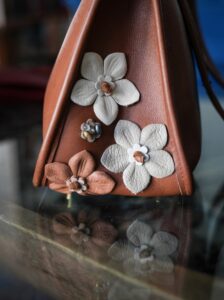Lucy Siegel’s obsession with salvaging vintage leather goods began at the swap shop at the transfer station in Wellfleet. There, four years ago, browsing with her sister, she found an old leather jewelry case. It was square, with a big metal zipper, a suede interior, and an embossed Coach logo. It was filthy.
“I picked it up and showed it to my sister, and she said, ‘Oh, that’s disgusting,’ ” Siegel says. She decided to take it home.

Then she got to work. First, she did a little research. How do you restore leather? And what about suede? Online, the answers varied, but Siegel used her intuition and cobbled together different pieces of advice. The main thing was getting the piece clean.
And once the grime was gone, she used different “potions and lotions” — Siegel’s not giving away her secrets — to rehydrate the leather and bring its rich color back. After some trial and error, the case looked brand new.
“I gave it to my son’s fiancé as a gift,” Siegel says. “I was so satisfied.”
From there, restoring vintage leatherware — mostly purses but also wallets, folios, and other odds and ends — became Siegel’s craft. Today, she sells these wares, searched out strategically, then rehabilitated with care, on her Etsy shop, which is called AbsolutelyBrilliant.
Siegel moved to Provincetown in 2017 after retiring from a 40-year career in public relations in New York City. For four generations, her family had been vacationing in Provincetown, starting with her grandparents in the 1920s. She came with her parents as a little girl and then, eventually, she brought her own children. Her grandfather’s paintings of Provincetown — docks and dunes, full of oddball characters — line the walls of Siegel’s home.

Siegel has learned that it’s important to start with good materials. She decided to stick to two brands: Coach and Dooney & Bourke. “They’re both well-made brands,” Siegel says. “Even if something is dilapidated looking, the quality of the material is still there.”
She finds vintage handbags on eBay and on Goodwill’s website. Siegel also listens in on what turns out to be an impassioned virtual community of people dedicated to refurbishing vintage leather.
“There are a lot of vehement arguments online about how to go about this whole process,” she says. “I dump the bags in the sink with tons of water and a little bit of Dawn soap. And some people say, ‘Why would you ever do that? You’re going to dry out the leather. You’re going to ruin the bag.’ But others, including Coach, say it’s totally fine to do that.”
On the coffee table in her living room, next to a batch of fresh-baked cookies, Siegel has laid out some of the purses she’s worked on. They look untouched, like they might in the display windows of a department store. There’s a vintage binocular bag, the same color as a glass of good Malbec, with a cross-body strap. It’s the perfect size: it could fit phone, keys, wallet, some cosmetic essentials, and a slim paperback. Next to is a kiltie bag — “I’m not sure where exactly the name comes from, but to me the bag has a Scottish look to it,” Siegel says. A standout is a tan Coach bag, detailed with flowers made of brown, white, and gray leather.

Most of the bags are 20 to 30 years old, and Siegel says each demands its own process of rehabilitation. Some come with a funky smell. “I have to use lots of vinegar and baking soda just to make them not reek,” she says. Sometimes, the leather is too stiff. “I just sit there for hours and, as I watch television or a movie, massaging it with a leather conditioner.”
For one bag, she taught herself how to dye leather. “I kept that bag for myself,” Siegel says. With each bag, she sets out on a different set of tasks: polishing brass, fixing clasps, finding identical replacement straps online, getting out water stains. In this way, she is a bit like an archaeologist of accessories: brushing out the soot and sediment and, under all of it, finding a still pristine treasure.
She views her purse projects not just as an artistic craft but as an environmentalist act. Getting rid of a well-made bag just because it needs TLC doesn’t make any sense to her. “Why throw something away when the material it is made of is still such good quality?”
Looking lovingly at the bags she’s been working on, Siegel repeats her mantra: “You can always give something a second life.”
Editor’s note: Because of a reporting error, an earlier version of this article, published in print on Feb. 8, incorrectly stated that Siegel uses “a ton” of Dawn soap to clean vintage leather. That would be a bad idea, she says. She uses only a small amount.
